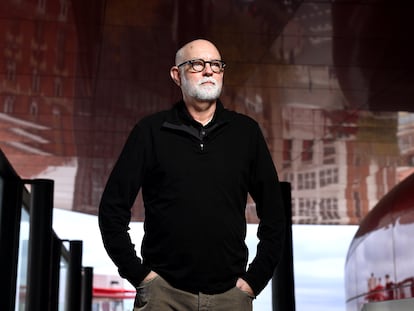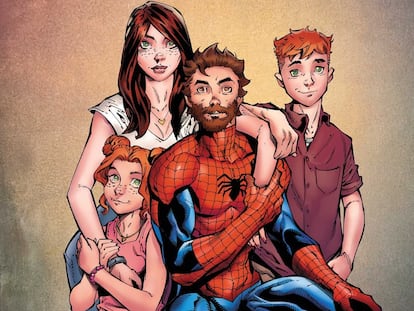Battles, social commentary and 80,000 characters: How Marvel forged the 21st century’s most worshipped gods
The ‘Marvel: Universe of Super Heroes’ exhibition travels through the publishing house’s evolution, from its early days with Stan Lee, Jack Kirby and Steve Ditko through its conversion into a cultural totem
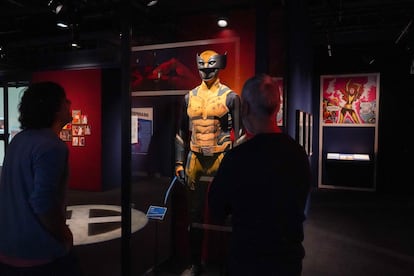

The Marvel method changed everything in the world of comics — though it was not without its collateral damage. When Stan Lee relaunched the superhero publishing house in the 1960s, the prolific writer had in mind a system that would allow for the publication of dozens of comics a month, which he would pen himself. The process would go like this: he’d write a script’s brief outline, the illustrator would make detailed drawings for it, structuring it into strips and then it would go back to Lee, who would write text to be inserted into the panels. So were born hundreds of concepts and characters in the space of a mere four months, many of which are still around to this day. But his methodology would also give rise to a certain antipathy between co-creators. As the years passed and Marvel’s success grew, Lee’s initial “scripts” were often reduced to a single, descriptive sentence that it fell to illustrators like Jack Kirby (who co-created the Fantastic Four and the Avengers) and Steve Ditko (who helped give birth to Spiderman and Doctor Strange) to develop into a 22-page comic. Soon enough, the illustrators were demanding bigger bylines and before the decade was over, had left the company. To this day, there are debates over who created what. Many of the characters these artists helped to flesh out are now financial windfalls for Marvel, revered by the masses.
Just as the faithful once entered the temples of Zeus and Athena to worship in ancient Greece, today, visitors may proceed through the dimly lit halls of the IFEMA Madrid conference center to pose with a statue of Spiderman hanging from the ceiling, or with Wanda Maximoff at a lectern. Behold the exhibition’s room recreating a classic drawing studio and know that the Marvel: Universe of Super Heroes is gazing back at its own phenomenon, and through the telling of its creation, seeking to understand just how it arrived at $40 billion in box office returns, with more than 60 films under its belt that have dominated modern theaters. That’s not even mentioning its omnipresent merch, which features its icons incarnated in the form of mugs, toys, hotels, clothes... One can hardly imagine, given this panorama, Lee’s own frustrated attempts to make the leap to Hollywood with The Incredible Hulk series in 1977, in which one actor played the human and another, the monster — though this too is registered in the sprawling expo.
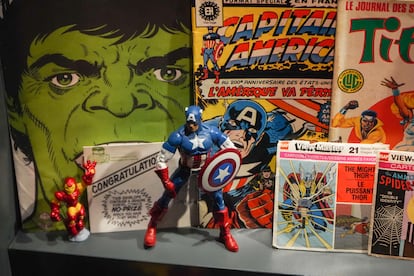
“None of these characters came out of nowhere. They were created by people. And there are hundreds of people working on each movie. We wanted to recognize everyone’s work and how that individual creation creates such a massive universe,” says curator Patrick A. Reed, a publishing expert who brought the exhibition to Spain after it passed through the United States and Switzerland. The show sums up 85 years of work and more than 80,000 characters — no easy task to transport.
Indeed, 20 trucks were needed to carry out logistics. And in those trailers came artifacts like the first Marvel Comics and Amazing Fantasy 15, which featured the first appearance of Spiderman back in 1962 (which sold in 2021 for $3.6 million), Daredevil illustrations by Frank Miller and others by Moebius of Silver Surfer. Here too is a typed script by Lee, a banned poster of the Twin Towers from the first Spiderman movie, many of which were found in the homes of collectors. Those trucks also transported the original armor used in the movie Iron Man and a Wolverine costume in which you can see bullet holes. The latter came directly from the recently released Deadpool and Wolverine and is one major attraction of an exhibition in constant evolution. “When we included a page from Moon Girl and Devil Dinosaur, we never imaged that it would become such a famous children’s animated series,” says Reed. Of course, Captain America’s shield is here, too.

All these objects are shown alongside explicatory texts that help visitors to connect the dots of each character’s creation. These are joined by Instagram-ready statues, like that of Thing from the Fantastic Four as well as the much more recently created Ms. Marvel, the publishing house’s first Muslim star. “We wanted an exhibition that could be enjoyed on various levels. Kids can take photos of themselves with Spiderman and adults can read the explanations,” says Reed, who built the show around three key points: comic history, the story behind each superhero, and the brand’s relevance in mass culture. A visitor can spend 20 minutes just checking out the movie costumes, or various hours reading into cultural context. If they’re gamers, they can try out the touch screens and interactive areas (now obligatory in any family-friendly expo), which give attendees the chance to take a flight in the Iron Man suit or play classic pinball machines and are sure to attract long lines of excited young ones during the Christmas season. All the while, music composed for the exhibition by movie music composer Lorne Balfe is piped in from surrounding speakers.
Why does Marvel continue to triumph as it does, and among such a mixed audience? Reed invokes the company’s classic slogan, “the world outside your window,” a reference to the realistic sense it seeks to impart through unrealistic settings and scenarios. Meaning, these comics are also home to love stories and the streets of New York City. Such grounding in reality seems a ballast in an era of encroaching artificial intelligence. “It’s the human and personal side of the creators that made Marvel so successful and why it continues to be successful. Having characters with problems that you can identify with, even when they’re in outer space, fighting a cosmic monster,” says Reed.
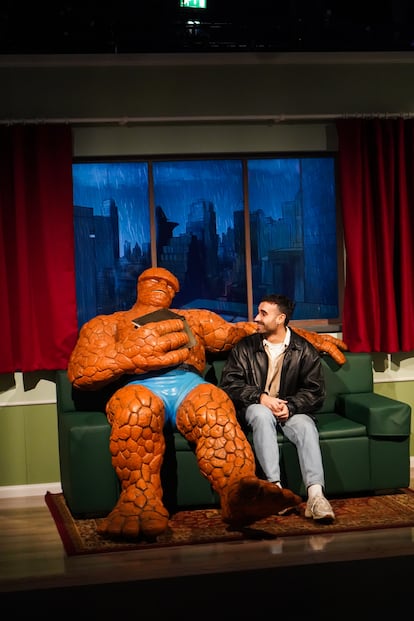
That fixed gaze on what is really happening in the world is what led Marvel to present the Black Panther character, who hails from the civil rights movement, and to portray its “persecuted and hated” mutants as followers of two leaders who reflect entirely different philosophies, contrasting Magneto’s Malcolm X-like leanings with Professor Xavier’s Martin Luther King-ish worldview. This social commentary, the exhibition has it, led to the publishing house making a definitive break from the previously dominant Comics Code Authority (CCA).
For just shy of 60 years, the CCA dictated the moral content of comic books, and even had a seal of approval that would be printed on publications that complied with its standards. Marvel broke with the organization in 1971, when Lee insisted on telling the story of Peter Parker’s drug-addicted friend, Harry Osborn. Its comics went even further when, in the middle of Watergate, Captain America faced off with the Secret Empire, which was led by a shadowy U.S. president who sought absolute power. Next year, that story will be adapted into film with Captain America (who is now a Black hero) taking on a president played by Harrison Ford who turns into a monster, a red version of The Hulk. The exhibition makes it clear how, between explosions and battles, Marvel has always made room for political messaging, even if today, many call for distance between politics and entertainment.
“They started making diverse comics because they lived in New York and saw all kinds of people on the subway, of all colors and genders. They created a world that was similar to their own,” says Reed, speaking of the Marvel artists. “In any creative collaboration, like with John Lennon and Paul McCartney, you have that tension that elevates the content. They are different people with their own perspective on the work, and that lends it more layers, more depth and detail. Creation is fluid, because these characters have been developed over decades, they’ve changed hands and design, name, backstory … the Wolverine we know today is a combination of hundreds of creators, and each one contributed to his evolution. It’s a difficult line, but we have to celebrate them all.” It’s a hard discussion, given that there are hundreds of authors who have wound up in poverty after not being properly compensated for their work, despite having created cultural icons known all around the world. In the end, the creator is always Marvel.
Everything changes, and everything remains the same. Today, this is the greatest victory of the Marvel method, according to the exhibition’s curator: “It is the longest-running serial, a work of collective fiction. For a generation of kids, Miles Morales is as much Spiderman as Peter Parker was for me.” Such figures remain in the collective subconscious. The superheroes have become more than their drawing tables, and have even surpassed their own creators.

Sign up for our weekly newsletter to get more English-language news coverage from EL PAÍS USA Edition
Tu suscripción se está usando en otro dispositivo
¿Quieres añadir otro usuario a tu suscripción?
Si continúas leyendo en este dispositivo, no se podrá leer en el otro.
FlechaTu suscripción se está usando en otro dispositivo y solo puedes acceder a EL PAÍS desde un dispositivo a la vez.
Si quieres compartir tu cuenta, cambia tu suscripción a la modalidad Premium, así podrás añadir otro usuario. Cada uno accederá con su propia cuenta de email, lo que os permitirá personalizar vuestra experiencia en EL PAÍS.
¿Tienes una suscripción de empresa? Accede aquí para contratar más cuentas.
En el caso de no saber quién está usando tu cuenta, te recomendamos cambiar tu contraseña aquí.
Si decides continuar compartiendo tu cuenta, este mensaje se mostrará en tu dispositivo y en el de la otra persona que está usando tu cuenta de forma indefinida, afectando a tu experiencia de lectura. Puedes consultar aquí los términos y condiciones de la suscripción digital.
More information
Archived In
Últimas noticias
Most viewed
- Sinaloa Cartel war is taking its toll on Los Chapitos
- Oona Chaplin: ‘I told James Cameron that I was living in a treehouse and starting a permaculture project with a friend’
- Reinhard Genzel, Nobel laureate in physics: ‘One-minute videos will never give you the truth’
- Why the price of coffee has skyrocketed: from Brazilian plantations to specialty coffee houses
- Silver prices are going crazy: This is what’s fueling the rally
